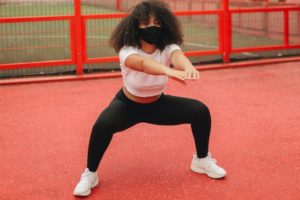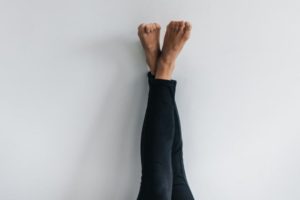Usually, bruises are induced by something coming into contact with the skin surface.
However, non-contact bruises can appear even when you may not have physically injured the area.

This type of bruising is known as a contusion. They are caused by exercises that are too intense, particularly workouts that require weight lifting.
The pressure can break blood vessels and result in bruises.
If you’ve ever noticed bluish, or purplish scabs on your legs after reps of squatting, here’s what you need to know.
Reasons for Bruises on Legs After Squats
Bruises are the result of blood vessels breaking, leading to blood leaking out under the skin, causing discoloration.
Squatting can sometimes cause bruises on the legs from pressure and friction that occurs during the exercise. This can happen for a few reasons:
Exercising for Too Long
Performing intense exercise for a long period puts a lot of pressure on your legs.
Such pressure weakens your blood vessels and muscles, which might ultimately result in bruising.
Barbell Placement
If you’re doing back squats, the barbell may be resting directly on your shoulders or upper back.
This causes pressure and friction on the skin and can lead to bruising.
Otherwise, you may have hit your legs against the barbell or caused unnecessary friction between your skin and clothing. This can also cause bruising.
Wrong Form While Squatting
If you’re getting bruised while squatting, it’s very likely your form is off. Squats look easy, and so people assume they don’t need instruction.
However, there are plenty of ways one can screw up the technique.
Wrong technique can lead to inefficient reps, not seeing results and even injury. Some common mistakes people make while squatting include:
- Bending forward at the hip.
- Not activating the core before entering the movement.
- Shifting their weight onto the toes.
- Letting knees collapse inwards.
- Not squatting low enough.
Genetics and Aging
Due to genetic factors, some people are more prone to bruising than others.
You may be more likely to experience leg bruising from squats if you have thin or sensitive skin.
Also, the blood vessels and skin thin out as you age. This can make you more prone to bruises under the pressure of exercise.
Medical Issue
Some people bruise easily because of medical issues.
Bruising on the legs without evident injury may be due to an underlying medical disorder or a medication.
For instance, nutritional deficiencies in vitamins and minerals such as vitamin K and vitamin C, which are necessary for blood clotting.
Taking blood-thinning medications like aspirin or anticoagulants also contributes to exercise-related bruising.
In some circumstances, blood clotting may be an underlying medical condition. When you exercise, the clot ruptures, resulting in a bruise effect.
Are Bruises on the Legs Dangerous?
Ordinarily, no, bruises on the leg are not dangerous. Therefore, they should not be a cause for alarm.
However, if you often bruise while engaging in less strenuous activities, you might be experiencing an issue with your blood or blood vessels.
What Should I Do About Bruises on the Leg after Squatting?
If you have bruises on your legs after squatting, it is likely that you strained the muscles in your legs.
Here are precautions to take to avoid bruising while exercising:
Warm-up Properly

Before you start your squats, make sure you warm up properly.
This can help to increase blood flow to your muscles, which can reduce the risk of bruising.
You can warm up by doing some light cardio, or some dynamic stretching.
Start with Lighter Weights
If you are new to squatting, it is important to start with lighter weights and gradually work your way up.
Build strength and avoid putting too much stress on your muscles.
Use Proper Form
Proper form is essential when squatting. To prevent bruises from squats, make sure you have proper form and technique.
Make sure you keep your knees aligned with your toes and your back straight.
This can help to distribute the weight evenly across your body and reduce the risk of bruising.
Moreover, ensure you’re in the perfect form while squatting. There are also different variations when you’re doing weighted squats.
To avoid injuries and maximize the benefits of the exercise, all joints and muscles must be moving appropriately.
Use Protective Equipment
If you are prone to bruising, you may want to consider using protective equipment, such as knee pads or compression sleeves.
These can help to cushion your knees and reduce the risk of bruising. Consider using a squat pad or a towel to cushion the barbell and reduce friction.
Here are some steps you can take to help your bruised leg heal and recover:
Rest and Recover
Be gentle with your body. Sometimes, bruises during exercise indicate that you need to rest and take care of your body.
Stop any activity that could worsen the injury. This includes squatting or any other exercises that put pressure on the bruised area.
Otherwise, you can switch up your activity types for less strenuous exercises.
Give your body adequate time to recover between workouts. You can gradually increase the weight you’re lifting over time.
This will save you from putting too much pressure on your legs at once.
Ice the Area
Applying ice to the affected area can help reduce swelling and relieve pain. Wrap a bag of ice or a cold pack in a towel.
Apply it to the bruised area for 15-20 minutes at a time. Do this several times a day. This will constrict blood vessels in the area and prevent further bleeding.
Elevate Your Legs

Keeping your leg elevated above your heart can prevent the blood from pooling and reduce swelling.
You can also spread up the healing process by bandaging the bruise.
Take Pain Relievers
Use normal pain management techniques like over-the-counter pain relievers. Acetaminophen or ibuprofen can help reduce pain and inflammation.
Also, over-the-counter ointments will soothe the pain.
Massage the Area
Gently massaging the affected area. This can help improve blood flow and promote healing.
See a Professional
Bruises often go away in two weeks without treatment. Otherwise, they can take up to 30 days to completely go away.
If your bruises don’t improve after a few days, you should see a doctor for further evaluation and treatment.
See a doctor if bruises appear frequently and there is no evident cause for them. If the bruises are serious and the limb is also swollen, get medical help right once.
If your doctor determines that your condition is not significant and you’re comfortable doing so, you can start exercising again.
This post is not a substitute for seeking professional medical advice. Consult your doctor to rule out an underlying medical issue.
You can also talk with a dietitian to find out if your diet is a contributing factor.
They will ensure that you’re not low in certain vitamins and minerals that make you more inclined to the bruising effect.
Conclusion
Any gym junkie has probably had one or two mystery bruises while lifting weights.
Whether you’re a beginner or advanced, you are not alone. While squatting, there’s a risk that the pressure from the weights could cause an injury.
Hence, it is important to always exercise safely.

Some people collect expensive old cars, and I’m into collecting bikes. I have 15 different bikes: special mountain bikes, sportbikes, professional, amateur, and city bikes. My friends and colleagues call me a ‘bike expert’ because I give advice on how to choose the right bike.
I’m also a massive fan of gym culture and heavyweight workouts. I met Alan at my local gym, and we’ve become friends quite soon. His idea of starting a sports blog seemed interesting to me, so I agreed to help.





